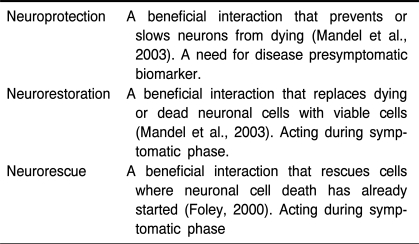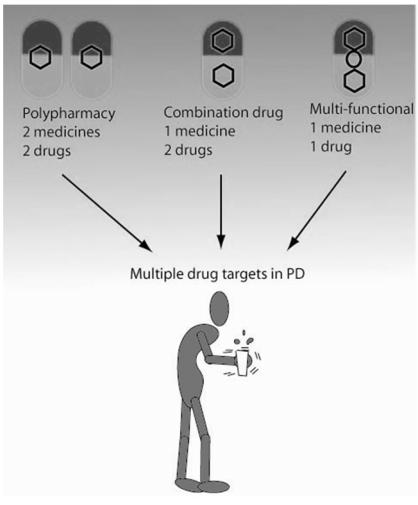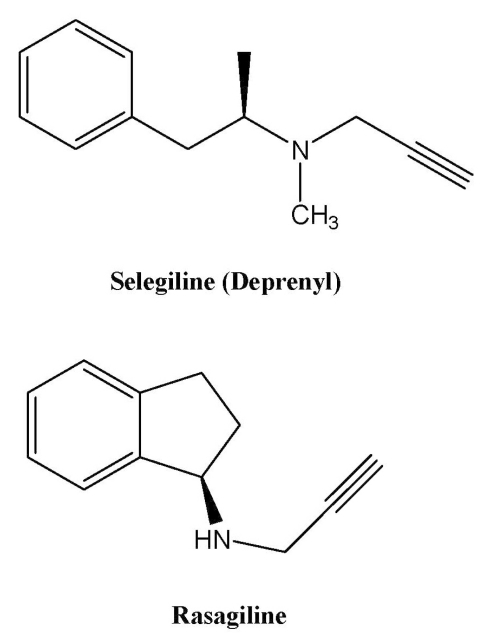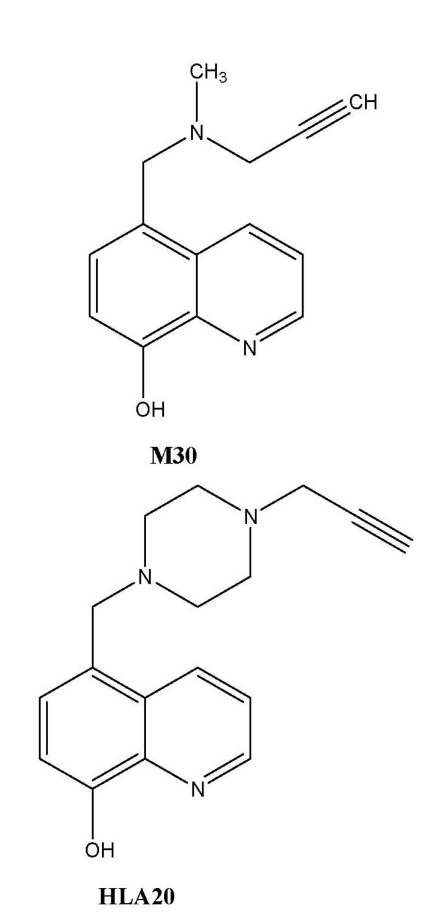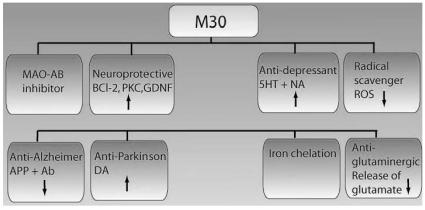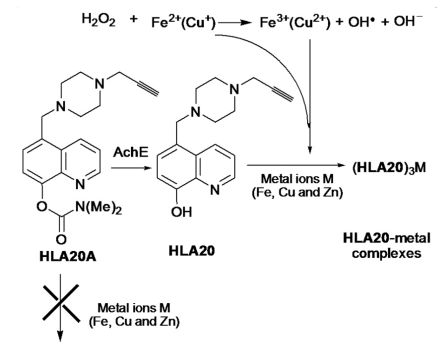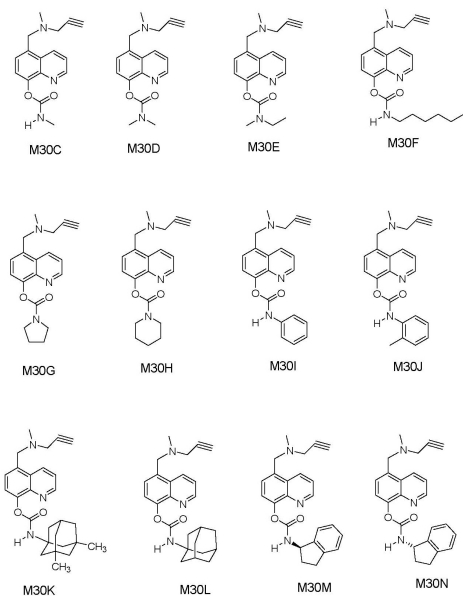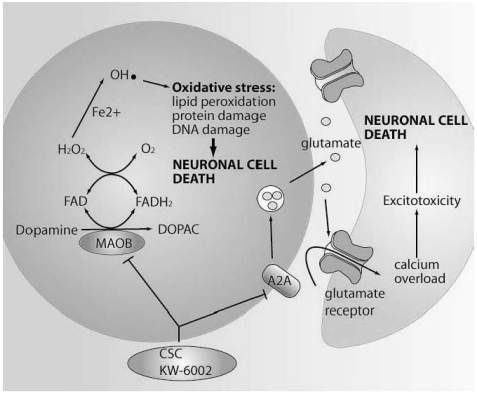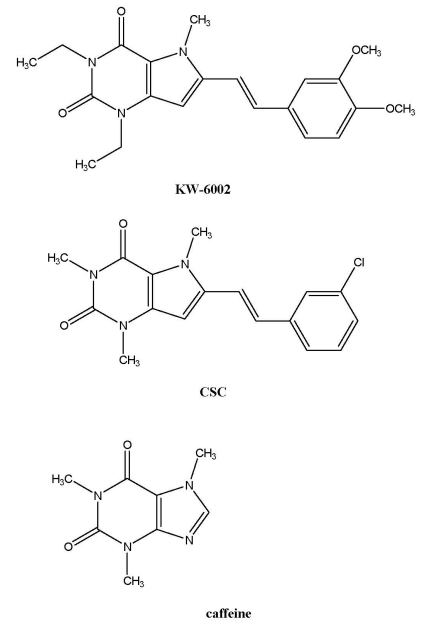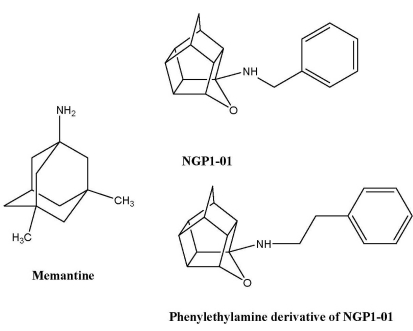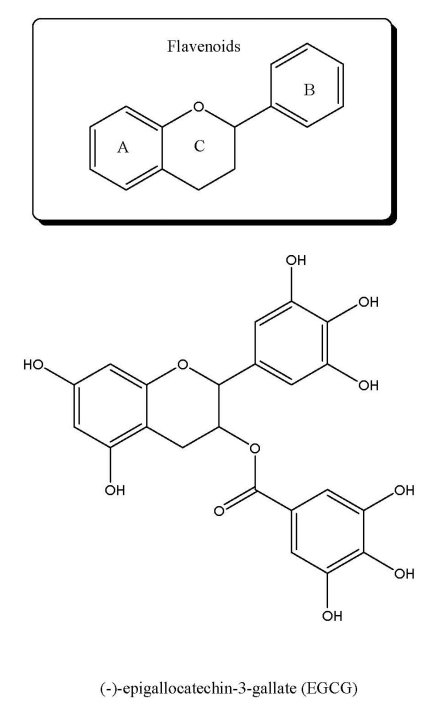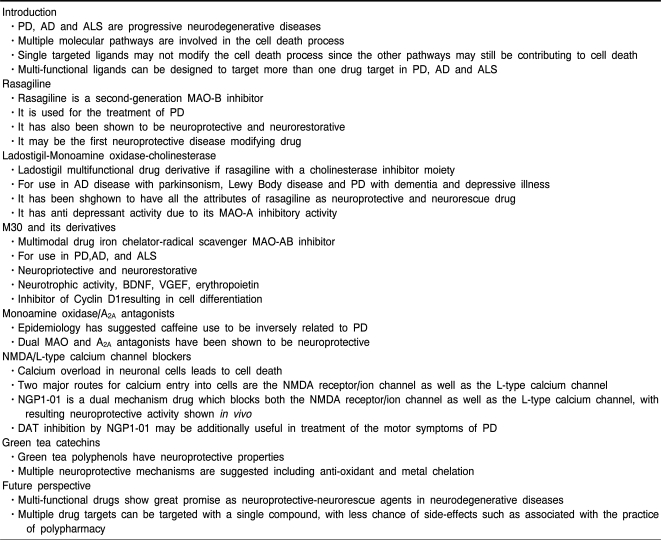Abstract
Parkinson's disease (PD) and Alzheimer's Disease (AD) are severe neurodegenerative disorders, with no drugs that are currently approved to prevent the neuronal cell loss characteristic in brains of patients suffering from PD and AD and all drug treatment are synptomactic. Due to the complex pathophysiology, including a cascade of neurotoxic molecular events that results in neuronal death and predisposition to depression and eventual dementia and etiology of these disorders, an innovative approach towards neuroprotection or neurorestoration (neurorescue) may be the development and use of multifunctional pharmaceuticals. Such drugs target an array of pathological pathways, each of which is believed to contribute to the cascades that ultimately lead to neuronal cell death. In this short review, we discuss examples of novel multifunctional ligands that may have potential as neuroprotective-neurorestorative therapeutics in PD and AD. The compounds discussed originate from synthetic chemistry as well as from natural sources.
Keywords: rasagiline, dual mechanism, adenosine, iron chelation
INTRODUCTION
Parkinson's disease (PD) is an age-related neurodegenerative disease with progressive loss of dopaminergic (DA) neurons in the substantia nigra pars compacta (SNpc). In patients, this depletion of neurons presents clinically with severe motor symptoms including uncontrollable resting tremor, bradikinesia, rigidity and postural imbalance (Lang and Lozano, 1998a; 1998b; Lotharius and Brundin, 2002). These symptoms, which affect 1% of individuals over the age of 65, start to manifest when 70~80% of DA neurons in the SNpc are lost (Mandel et al., 2003; Meissner et al., 2004). The exact etiology of PD remains to be fully elucidated, but the key theories propose either an environmental (e.g. insecticides (Calne et al., 1987; Schoenberg, 1987; Paolini et al., 2004)) or a genetic (e.g. parkin (Kitada et al., 1998)) origin, or a combination of both.
In 2009, the market value for PD and AD therapies exceeded US$6.5 billion, (Schapira et al., 2005) with projections that these will surpass cancer as the second most common cause of death of the elderly (Lang and Lozano, 1998a). Therefore, there is a real sense of urgency to discover novel therapies for the treatment or preferably, prevention of these diseases. Currently the only therapies approved for the treatment of PD and AD are agents that attenuate the symptoms (symptomatic) of the disease without disease modifying activity except the anti Parkinson drug rasagiline (Azilect) (Olanow et al., 2009), which we developed (Youdim et al., 2005). The mainstay for PD treatment focuses on the replacement of lost DA with L-dopa, dopamine (DA) agonists, monoamine oxidase B inhibitors and catechol-O-methyl tranferase inhibitors, thereby normalizing the patient symptomatically (Schapira et al., 2005). While for AD there are the cholinesterase inhibitors and the glutamate antagonist memantine. Tragically, but important in view of the seriousness of disease progression, is the fact that the course of the disease is not affected by the utilization of these drugs, and the loss of neurons continues unabated even as symptoms may be controlled, at least following initial treatment. Currently, no drugs with claimed neuroprotective activity have been approved by the FDA for the treatment of PD or AD (Table 1) (Mandel et al., 2003; Stocchi and Olanow, 2003). Significantly though, recent research has suggested that some drugs used for symptomatic relief in PD, such as Azilect, pramipexole (Hall et al., 1996; Dooley and Markham, 1998; Piercey, 1998) and memantine (Rogawski and Wenk, 2003; Plosker and Lyseng-Williamson, 2005) may also possess neuroprotective activities, rasagiline is currently only drug that may have a disease modifying activity (Olanow et al., 2009).
Table 1.
Definitions of the terms neuroprotection, neurorestoration and neurorescue
Recent literature show that there has been a paradigm shift in the way researchers are considering the development and design of drugs to treat diseases with complex etiological pathways (i.e. diseases with multiple drug targets) (Morphy et al., 2004; Gal et al., 2005; Morphy and Rankovic, 2005; Youdim and Buccafusco, 2005a; 2005b; Van der Schyf et al., 2006a; 2006b; Zimmermann et al., 2007). In a pathway system with a multitude of drug targets, a drug with a single-target mechanism of action cannot always compensate or correct a complex pathway, which suggests that a complex pathway disease should be treated 1) with a multitude of molecules, each acting on different pathways in the disease (polypharmacy), or 2) with one molecule that possesses promiscuous activity acting on different pathways (multiple mechanism drugs).
Polypharmacy (Fig. 1) therefore, is the clinical practice of combining two or more medications in a patient's medication profile, with a view to treat one specific disease. For example, the combination use of salmeterol (a β2-adrenergic agonist) and fluticasone (a glucocorticoid steroid) in asthma, has led to the combination of these two medications in one (Advair®). Also, the combination (in Vytorin®) of simvastatin (an HMG-CoA reductase inhibitor) and ezetimibe (an inhibitor of dietary cholesterol uptake) is used to treat hyperlipidemia (Zimmermann et al., 2007). The major dilemma encountered in a polypharmaceutical approach, is a significant chance increase in side effects, which may be reduced statistically with the use of only one compound. The recent appearance on the market of drugs that display two mechanisms to treat a particular disease has been a clear move in the direction of the latter paradigm. One example, duloxetine (Cymbalta®), used in the treatment of depression, inhibits both serotonin and norepinepherine uptake in the central nervous system (CNS) (Wong et al., 1988; Kihara and Ikeda, 1995; Goldstein et al., 2002). The introduction of drugs such as duloxetine indicates the clinical feasibility of designing multi-functional ligands to treat CNS disorders with complex disease pathways.
Fig. 1.
Three approaches towards combination drug therapy in a multi-target disease (adapted from (MorphyRankovic, 2005)).
In this review, we will consider examples of compounds with multi-functional neuroprotective-neurorescue (Table 1 for definitions) properties that may have promise in the treatment of PD and similar approaches have been made for multimodal drugs for AD (Youdim et al., 2006; Zheng et al., 2009), but for the present discussion we shall focus on PD only. Some of the compounds discussed were discovered through serendipity while others were the products of active drug design projects.
Rasagiline
Rasagiline is a newly approved compound for the treatment of PD (Fig. 2; Schapira et al., 2005). Rasagiline (N-propargyl-1R-aminoindan) is an anti-PD drug with selective MAO-B inhibitory activity (Youdim et al., 2005a). Its S isomer, TV1022 (N-propargyl-1S-aminoindan), is more than a 1,000 times less potent as an MAO inhibitor than rasagiline, but still retains neuroprotective activity, which suggests that the propargylamine moiety (even when ostensibly not involved in Michael chemistry at the FAD within the MAO catalytic site as the processing group in suicide inhibition) is responsible for the neuroprotective activity seen in both these compounds (Weinreb et al., 2004a; Bar-Am et al., 2005; Youdim et al., 2005b; Zheng et al., 2005a).
Fig. 2.
Chemical structures of Selegiline and Rasagiline.
The selectivity of rasagiline as an MAO-B inhibitor compared with TVP-1022, is thought to be associated with the ability of rasagiline to enter the catalytic site gorge of MAO-B. On the other hand, the configuration of the S-isomer imparts a highly restrictive conformation on the enzyme-ligand complex, which prevents the molecule from entering the catalytic site, precluding it from acting as a mechanism-based inhibitor. Interestingly, the neuroprotective activity associated with these compounds has now been shown to be associated with the ability of propargylamine (Weinreb et al., 2004a; Bar-Am et al., 2005) to protect mitochondrial viability by activation of Bcl-2 and protein kinase C (PKC)α and ε, and by down regulating proapoptotic FAS and Bax, and PKCδ and -γ (Youdim et al., 2005a). Additionally, these drugs induce the release of the soluble neuroprotective-neurotrophic form of the amyloid precursor protein α (sAPPα) through a PCK-MAP mediated activation of α-secretase (Youdim and Buccafusco, 2005b).
The identification of the propargylamine moiety as a key element that confers neuroprotective activity and, in cases such as rasagiline and selegiline, also MAO inhibitory activity, led to the development of AchE inhibitors such as ladostigil (TV3326, now in phase II clinical studies), another anti-Alzheimer (AD)/anti-PD/antidepressant drug (Sterling et al., 2002; Weinstock et al., 2002; Youdim et al., 2005a; Youdim and Buccafusco, 2005b). Ladostigil (Fig. 3) is a dual acetylcholine-butyrylcholine-esterase, and brain-selective MAO-A/B inhibitor in vivo, designed by combining the carbamate cholinesterase inhibitory moiety found in the rivastigmine molecule, with the pharmacophore of rasagiline and TVP1022 both of which possess the propargylamine moiety. Ladostigil has been shown to have antidepressant activity due to its ability to inhibit MAO-A in the raphe nucleus, striatum, hippocampus, and hypothalamus, and to raise brain levels of DA, norepinephrine, and serotonin (Weinstock et al., 2002). Its ability to also inhibit MAO-B attenuates 1-methyl-4-phenyl-1,2,3,6-tetrahydropyridine (MPTP) toxicity in mice, a rodent model of parkinsonism (Sagi et al., 2003). Although a poor MAO-B inhibitor, the S isomer of ladostigil, TV3279, has shown similar neuroprotective activity to rasagiline and ladostigil in vitro and in laboratory animals (Youdim and Buccafusco, 2005b), with molecular mechanisms apparently identical to that of rasagiline.
Fig. 3.
Design of Ladostigil.
Iron chelators with radical scavenging and brain-selective monoamine oxidase inhibitory activity
Degenerating nigrostriatal DA neurons are the main pathological feature in the SNpc of PD sufferers. In addition, many PD patients also experience dementia and depression that likely result from sporadic neurodegeneration in cholinergic, noradrenergic, and serotonergic pathways. In PD, accumulation of iron is found inside some melanin-containing DA-ergic neurons and inside amyloid plaques and neurofibrillary tangles associated with PD dementia (Zecca et al., 2004). It has been suggested that iron accumulation may contribute to the oxidative stress-induced apoptosis reported in both PD and PD dementia (Zecca et al., 2004; Youdim et al., 2005b). Such oxidative stress may result from increased glial monoamine oxidase (MAO) activity leading to exacerbated hydrogen peroxide production that can generate reactive hydroxyl radical through Fenton chemistry with intracellular ferrous iron. Iron chelators such as desferoxamine, clioquinol and VK-28 have been shown to have neuroprotective activity in animal models of AD and PD (Zecca et al., 2004).
Based on this proposal, Zheng et al. (2005b) developed neuroprotective compounds with dual iron chelating and MAO-B inhibitory activity. These authors combined the antioxidant chelator moiety present in an 8-hydroxyquinoline derivative of the neuroprotective brain-permeable iron chelator VK-28, with the propargylamine moiety (found in compounds such as rasagiline and selegiline, as stated earlier). HLA20 was identified as a potential lead compound for further studies having selectivity for MAO-B with an IC50 value in the region of 110µM (Fig. 4; >200µM for MAO-A), as well as acting as a free radical scavenger. However, a related compound designated M30, unlike HLA20 was found in vitro, to be a highly potent MAO-A and B inhibitor with brain selectivity for these enzymes in vivo, in addition to possessing iron chelating properties similar to desferoxamine (Gal et al., 2005; Zheng et al., 2005a; 2005b). M30 behaves similarly to other propargylamine MAO inhibitors by acting as a suicide- or mechanism-based inhibitor after being identified and processed as a substrate by the enzyme and imparts similar neuroprotective properties as those found in rasagiline and ladostigil (Fig. 5). M30 protects against MPTP and kainate neurotoxicity in mice by virtue of both its MAO inhibitory and iron chelating/radical scavenging properties in these two animal models of neurodegeneration. It has recently been shown to have dopaminergic neurorestorative activity in post treatment with MPTP (Gal et al., 2009) and lactacystin (Zhu et al., 2007) models of PD. The neurogenic activity of M30 and HLA-20 has been attributed to the inhibition of iron dependent prolyl-4-hydroxylase, via chelation of iron and activation of HIF (hypoxia inducing factor) that regulates transcription of a series of neurotropins such as BDNF, GDNF, erythropoietin and VEGF. The Consequence of HIF activation is inhibition of cell cycle G0/G1, that results in inhibition of cyclin D1 that causes cell arrest differentiation into neurons as seen in the neurorestorative activity of M30 in the two models of PD (Zhu et al., 2007; Gal et al., 2009; Kupershmidt et al., 2009).
Fig. 4.
Chemical structures of M30 and HLA20.
Fig. 5.
Neuroprotective effects of M30. See text for discussion.
For AD therapeutics we have introduced a carbamate cholinesterase inhibitor (ChEI) moieties into M30, such as M30C-N and into HLA-20 to give HLA-20A and have even added the glutamate antagonist, memantine, which is presently in the clinical use. These compounds HLA-20A (Fig. 6) and M30C-N (Fig. 7) have been shown to have potent ChE I and MAO-A and B inhibitory activity and possess similar neuroprotective activity to those of their parent compounds, HLA-20 and M30 (Zheng et al., 2009).
Fig. 6.
Novel multimodal cholinesterase-iron chelating-radical scavenging drug for Alzheimer; disease (Zheng et al., 2006).
Fig. 7.
Novel multimodal cholinesterase-monoamine oxidase inhibitor-iron chelator-radical scavenger for Alzheimer's disease with parkinsonism, Parkinson's disease with dementia and Lewy body disease (submitted for publication).
The accumulation of iron at sites where neurons degenerate in PD, is thought to be a major event that is linked to the neurodegenerative process (Zecca et al., 2004). The novel non-toxic lipophilic (and therefore brain-permeable) iron chelator VK-28, and its multi-functional derivative, M30 (both of which possess the MAO inhibitory and neuroprotective propargyl moiety of rasagiline), offer potential therapeutic benefits for PD. M30 attenuates apoptotic events in SH-SY5Y neuroblastoma cells in a serum deprivation model via multiple protection mechanisms, including 1) reduction of the pro-apoptotic proteins, Bad and Bax; 2) reduction of apoptosis-associated Ser139-phosphorylated H2A.X; 3) induction of the anti-apoptotic protein, Bcl-2 and 4) inhibition of the cleavage and activation of caspase-3. M30 also promotes morphological changes, resulting in axonal growth-associated protein-43 (GAP-43), which is implicated in neuronal differentiation. The compound markedly reduces the levels of cellular holo-APP, the β-C-terminal fragment (β-CTF), and levels of amyloidogenic Aβ peptide in the medium of SH-SY5Y and CHO cells stably transfected with the APP "Swedish" mutation. In addition, levels of the nonamyloidogenic sAPPα in cell medium, as well as levels of α-CTF in cell lysate were found to be elevated. These results are consistent with the presence of an iron-responsive element (IRE) in the 5'-untranslated region (5'UTR) of APP and demonstrate the effectiveness of M30 in limiting holo-APP expression and Aβ peptide secretion. Therefore, the multifunctional properties of M30 suggest that it may offer extraordinary potential as a drug for the treatment of PD, especially PD dementia (Avramovich-Tirosh et al., 2006) and AD (Mandel et al., 2007; Amit et al., 2008) and more recently in transgenic G93A SOD model of ALS (amyotrophic lateral sclerosis) where it extends the life span of these animals and has neurogenic activity in NCS-34 rat motor neurons (Kupershmidt et al., 2009).
Monoamine oxidase inhibition by A2A receptor antagonists
In PD, a dual mechanism that includes inhibition of MAO-B, as well as adenosine A2A receptor blockade offer a novel therapeutic approach to prevent neuronal cell death (Fig. 9). As detailed earlier, MAO-B plays a role in the catabolism of neurotransmitters such as DA, serotonin and norepinephrine, leading to hydrogen peroxide formation which contributes to oxidative stress and neuronal cell death (Riederer et al., 2004). Levels of MAO-B are found to be increased in older patients (Saura et al., 1994; 1997; Mahy et al., 2000) which has led to the rationale for the use of drugs such as selegiline (deprenyl) and lazabemide, (Sramek and Cutler, 1999) and the design of drugs such as ladostigil, (Youdim and Buccafusco, 2005b) as described before.
Fig. 9.
Dual mechanism of MAOB/A2A antagonists in a neuron.
Caffeine, a non-selective adenosine receptor antagonist, is under some scrutiny as a potential drug to counteract age-related cognitive decline (Fig. 8). Work in this regard is supported by evidence that critical changes in adenosine-related neurotransmission occur with aging and may be counteracted by adenosine receptor antagonists (Maiade and Mendonca, 2002; Dall'Igna et al., 2003; Prediger et al., 2005). Caffeine, in fact, has been suggested to protect against β-amyloid neurotoxicity, (Dall'Igna et al., 2003) while acute treatment with caffeine and the A2A receptor antagonist ZM241385 was recently found to reverse age-related olfactory deficits and memory decline in rats (Prediger et al., 2005) clearly suggesting involvement of A2A, but not A1 receptors, in cognitive decline and possibly, neurodegenerative processes. Evidence such as the preceding, and other evidence for neuroprotection also in parkinsonian models, led Petzer et al. (Petzer et al., 2003) to evaluate (E)-8-styrylxanthinyl derived adenosine A2A receptor antagonists for inhibition also of brain MAO-B. Included in these studies were KW-6002, a potent A2A receptor antagonist (Ki of 2.2 nM) which is undergoing clinical trials for PD, and (E)-8-(3-chlorostyryl)-caffeine (CSC; Fig. 8), which has been shown to be neuroprotective in the MPTP parkinsonian mouse model (Chen et al., 2002). All of the compounds tested in the studies by Petzer et al. (Petzer et al., 2003) showed MAO-B inhibition in the low micromolar to high nanomolar range, with the Ki of KW-6002 at 21µM, and that of CSC at 0.1µM. These results clearly suggest that the neuroprotective properties of KW-6002 and CSC may in part be due to MAO-B inhibition, in synergism with the A2A antagonism (Castagnoli et al., 2003).
Fig. 8.
Chemical structures of adenine receptor antagonists.
NMDA antagonism by calcium channel blockers
The divalent calcium cation plays an important role in neuronal cell death (Lipton, 1999; Horn and Limburg, 2000; Kemp and McKernan, 2002; Ovbiagele et al., 2003). One of the receptors activated by glutamate (together with its co-agonist glycine), the NMDA receptor, is a major conduit for the influx of calcium ions into cells under excitotoxic conditions. The prevention of such excessive influx of calcium (known as excitotoxicity) therefore remains a major drug target in the design of neuroprotective agents. Excess accumulation of calcium in neuronal cells rapidly leads to cell death through a variety of mechanisms including activation of proteases, nucleases, phospholipases, nitric oxide synthase (NOS), and other degradative enzymes that not only lead to activation of death cascades, but also to free radical formation (Lipton, 1999). NMDA receptor antagonists such as dizocilpine (MK-801) and memantine may possess a dual mechanism by which neuronal cells are protected, both by direct blockade of the NMDA receptor and by attenuating TNFα-induced potentiation of glutamate toxicity (Zou and Crews, 2005).
Brain injury after ischemic stroke also triggers a release of glutamate-associated excitotoxic events, and the incidence of cognitive impairment and dementia have both been reported to be elevated after cerebral stroke, especially in the elderly (Kalaria and Ballard, 2001). Up to 25% of stroke patients exhibit symptoms of dementia, including symptoms reminiscent of PD dementia (van Kooten and Koudstaal, 1998). Stroke is the third leading cause of death in the United States (Ovbiagele et al., 2003) and there is a definitive need to develop drugs that can protect or save neurons after an ischemic incident since, to date, no effective treatment has been developed to prevent neuronal cells from dying during stroke conditions (Horn and Limburg, 2000).
Several studies have shown that NMDA receptor antagonists, such as dizocilpine (MK-801) and the polycyclic cage amine memantine, display neuroprotective effects in experiments using ischemia paradigms in neurons (Gorgulu et al., 2000; Horn and Limburg, 2000; Gerriets et al., 2003; Richard Green et al., 2003). An alternative pathway for calcium to enter into neuronal cells is through voltage-gated ion channels, such as L-type calcium channels. Animal experiments with nimodipine have suggested that calcium channel antagonists may be neuroprotective in ischemia by antagonizing the influx of calcium into neuronal cells (Horn and Limburg, 2000). The importance of calcium overload during cell death, suggests that a dual calcium channel and NMDA receptor antagonist might be useful as a neuroprotective drug in stroke and other neurodegenerative disease such as idiopathic PD, where it has been suggested that brain-permeable L-type calcium channel blockers may have a salutary effect on the disease.
NGP1-01 (8-benzylamino-8,11-oxapentacycloundecane) is a polycyclic cage amine derived from the reductive amination of benzylamine and Cookson's "bird cage" diketone of which the biology was first described by Van der Schyf (Van der Schyf et al., 1986) (Fig. 10). The L-type calcium channel blocking activity of NGP1-01 was investigated utilizing electrophysiological experiments in isolated guineapig papillary muscle and sheep Purkinje fibers (Van der Schyf et al., 1986). The structural similarity of NGP1-01 to another polycyclic cage amine and NMDA receptor antagonist, memantine, led to the evaluation of NGP1-01 for potential NMDA receptor antagonism. Memantine is an uncompetitive NMDA receptor antagonist which is used clinically to treat AD, but has also been used for PD in Germany (Parsons et al., 1999; Rogawski and Wenk, 2003; Plosker and Lyseng-Williamson, 2005). Its favorable fast on-off binding kinetics gives this compound an improved side effect profile compared with other NMDA antagonists such as MK-801 (Parsons et al., 1999). NGP1-01 was shown to also be an uncompetitive NMDA antagonist in murine whole brain synaptoneurosomes and blocked NMDA-mediated 45Ca2+ uptake with an IC50 of 2.98µM (Geldenhuys et al., 2007).
Fig. 10.
Chemical structures of NGP-01 and its derivatives.
In a recent paper Kiewert et al. (2006) showed that NGP1-01 (at 1µM) inhibited depolarizationinduced calcium influx by 78% in cortical neurons preloaded with fura-2 AM, with a potency similar to that of nimodipine, while simultaneously inhibiting NMDA-induced (1 mM) calcium influx by 52%, only slightly less potent than memantine. Using in vivo-microdialysis, choline release was monitored during NMDA infusion as a measure of excitotoxic membrane breakdown. Intraperitoneal injection of NGP1-01 (40 mg/kg) reduced NMDA-induced membrane breakdown by 31% (p<0.01) while memantine (10 mg/kg) reduced choline release by 40%. These results demonstrate that NGP1-01 simultaneously blocks both major neuronal calcium channels and is brain-permeable after peripheral administration. This dual mechanism of modulating calcium entry into neuronal cells might suggest that NGP1-01 may have utility as a neuroprotective agent in PD, stroke and other neurodegenerative diseases, especially in patients with comorbidity among these diseases. This promise of neuroprotection has recently been partly confirmed in in vivo studies using the middle cerebral artery occlusion (MCAO) mouse model of stroke, wherein it was shown that NGP1-01, administered 30 minutes before MCAO, afforded substantial protection against cerebral ischemia-induced brain lesioning, as well as brain swelling measured 24 hours after MCAO (Mdzinarishvili et al., 2005).
Another role assigned to cage amines such as NGP1-01 in PD therapy is the ability of these compounds to inhibit DA re-uptake into nerve terminals (Fig. 10). Compounds that are able to block the DA transporter (DAT) have been suggested to be more useful in treating the motor symptoms in PD, as opposed to norepinephrine and serotonin re-uptake inhibitors (Hansard et al., 2002). Additionally, compounds with the ability to block DAT, may also have neuroprotective activity (Kirby et al., 2002). NGP1-01 was recently shown to block DA re-uptake in murine synaptosomes with an IC50 of 57µM. One of NGP1-01's derivatives, a phenylethylamine derivative, was even more potent with an IC50 of 23µM (Geldenhuys et al., 2004). The latter compound was also found to be neuroprotective in the MPTP-parkinsonian mouse model, affording protection against a single 35 mg/kg (ip) dose of 1-methyl-4-phenyl-1,2,3,6-tetrahydropyridine (MPTP) (Geldenhuys et al., 2003).
Green tea polyphenols
Polyphenols are natural products present in beverages such as red wine and tea (Weinreb et al., 2004b). One of the classes of polyphenols which are pharmaceutically interesting is the flavenoids (Fig. 11). These compounds are characterized by an aromatic ring which is condensed to a heterocyclic ring and attached to a second aromatic ring. An innovative therapeutic approach could be the use of natural plant polyphenol flavonoids, reported to have access to the brain and to possess multifunctional activities as iron chelators, radical scavengers, anti-inflammatory agents and neuroprotectants (Morel et al., 1993; Guo et al., 1996; Hider et al., 2001; Joseph et al., 2005).
Fig. 11.
Chemical structures of flavenoids and EGCG.
These compounds and their actions have been extensively reviewed (Mandel et al., 2005). In particular, the major constituent of green tea catechin extract (-)-epigallocatechin-3-gallate (EGCG; Fig. 11) plays a major role in the prevention of neurodegeneration in a variety of cellular and animal models of neurodegenerative diseases (Mandel et al., 2006). This effect appears to be mediated through multiple pathways, including the participation of the pro-survival PKC and extracellular mitogen-activated protein kinase (MAPK) signaling and the promotion of neurite outgrowth (Reznichenko et al., 2005). Structurally important features defining their chelating potential are the 3',4'-dihydroxyl group in the B ring (Hider et al., 2001), as well as the gallate group (Kumamoto et al., 2001) which may neutralize ferric iron to form redox-inactive iron, thereby protecting cells against oxidative damage (Grinberg et al., 1997). Recent studies have shown that prolonged administration of EGCG to mice induced a significant reduction in membrane-associated APP levels in hippocampus (Levites et al., 2003) and in cerebral Aβ levels concomitant with reduced β-amyloid plaques (Rezai-Zadeh et al., 2005). This effect may be accounted for, in part, by the chelation of the intracellular free-iron labile pool, modulating APP mRNA translation via its IRE-type II (Reznichenko et al., 2006), as has recently been described for other metal chelators, such as desferoxamine, clioquinol and dimercaptopropanol (Payton et al., 2003; Rogers and Lahiri, 2004).
DISCUSSION
PD and AD are complex diseases with multiple pathways which contribute to its etiology and finally cell death of DA-ergic, cholinergic and other neurons. To address this multiplicity, compounds that target more than one drug target in the cell death cascades are now investigated and designed. The feasibility of moving these drugs to market has been shown through the success of rasagiline, which has been shown to have neuroprotective activity and has made it to the market as a PD therapeutic (Olanow et al., 2009). The development of multimodal drugs is not limited to neurodegenerative disease, but rather that similar approaches are under way with other complex disease such as cancer, AIDS, depressive illness, schizophrenia and possibly cardiovascular disorders (Youdim and Van der Schyf, 2009).
ACKNOWLEDGEMENTS
This work was supported by WCU (World Class University) program through the National Research Foundation of Korea funded by the Ministry of Education, Science and Technology (R33-10014 to Dr. Young Jun Oh at Yonsei University).
Executive summary
References
- 1.Avramovich-Tirosh Y, Amit T, Bar-Am O, Zheng H, Fridkin M, Youdim MB. Therapeutic targets and potential of the novel brain-permeable multifunctional iron chelator-monoamine oxidase inhbitor drug, M-30, for the treatment of Alzheimer's disease. J Neurochem. 2006;100:490–502. doi: 10.1111/j.1471-4159.2006.04258.x. [DOI] [PubMed] [Google Scholar]
- 2.Bar-Am O, Weinreb O, Amit T, Youdim MB. Regulation of Bcl-2 family proteins, neurotrophic factors, and APP processing in the neurorescue activity of propargylamine. FASEB J. 2005;19:1899–1901. doi: 10.1096/fj.05-3794fje. [DOI] [PubMed] [Google Scholar]
- 3.Calne S, Schoenberg B, Martin W, Uitti RJ, Spencer P, Calne DB. Familial Parkinson's disease: possible role of environmental factors. Can J Neurol Sci. 1987;14:303–305. doi: 10.1017/s0317167100026664. [DOI] [PubMed] [Google Scholar]
- 4.Castagnoli N, Jr, Petzer JP, Steyn S, Castagnoli K, Chen JF, Schwarzschild MA, Van der Schyf CJ. Monoamine oxidase B inhibition and neuroprotection: studies on selective adenosine A2A receptor antagonists. Neurology. 2003;61:S62–S68. doi: 10.1212/01.wnl.0000095215.97585.59. [DOI] [PubMed] [Google Scholar]
- 5.Chen JF, Steyn S, Staal R, Petzer JP, Xu K, Van Der Schyf CJ, Castagnoli K, Sonsalla PK, Castagnoli N, Jr, Schwarzschild MA. 8-(3-Chlorostyryl)caffeine may attenuate MPTP neurotoxicity through dual actions of monoamine oxidase inhibition and A2A receptor antagonism. J Biol Chem. 2002;277:36040–36044. doi: 10.1074/jbc.M206830200. [DOI] [PubMed] [Google Scholar]
- 6.Dall'Igna OP, Porciuncula LO, Souza DO, Cunha RA. Neuroprotection by caffeine and adenosine A2A receptor blockade of beta-amyloid neurotoxicity. Br J Pharmacol. 2003;138:1207–1209. doi: 10.1038/sj.bjp.0705185. [DOI] [PMC free article] [PubMed] [Google Scholar]
- 7.Dooley M, Markham A. Pramipexole. A review of its use in the management of early and advanced Parkinson's disease. Drugs Aging. 1998;12:495–514. doi: 10.2165/00002512-199812060-00007. [DOI] [PubMed] [Google Scholar]
- 8.Foley P, Gerlach M, Youdim MBH, Riederer P. MAO-B inhibitors: multiple roles in the therapy of neurodegenerative disorders? Parkinsonism and Related Disorders. 2000;6:25–47. doi: 10.1016/s1353-8020(99)00043-7. [DOI] [PubMed] [Google Scholar]
- 9.Gal S, Zheng H, Fridkin M, Youdim MB. Novel multifunctional neuroprotective iron chelator-monoamine oxidase inhibitor drugs for neurodegenerative diseases. In vivo selective brain monoamine oxidase inhibition and prevention of MPTP-induced striatal dopamine depletion. J Neurochem. 2005;95:79–88. doi: 10.1111/j.1471-4159.2005.03341.x. [DOI] [PubMed] [Google Scholar]
- 10.Geldenhuys WJ, Malan SF, Bloomquist JR, Van der Schyf CJ. Structure-activity relationships of pentacycloundecylamines at the N-methyl-d-aspartate receptor. Bioorg Med Chem. 2007;15:1525–1532. doi: 10.1016/j.bmc.2006.09.060. [DOI] [PubMed] [Google Scholar]
- 11.Geldenhuys WJ, Malan SF, Murugesan T, Van der Schyf CJ, Bloomquist JR. Synthesis and biological evaluation of pentacyclo[5.4.0.0(2,6).0(3,10).0(5,9)]undecane derivatives as potential therapeutic agents in Parkinson's disease. Bioorg Med Chem. 2004;12:1799–1806. doi: 10.1016/j.bmc.2003.12.045. [DOI] [PubMed] [Google Scholar]
- 12.Geldenhuys WJ, Terre'Blanche G, Van der Schyf CJ, Malan SF. Screening of novel pentacyclo-undecylamines for neuroprotective activity. Eur J Pharmacol. 2003;458:73–79. doi: 10.1016/s0014-2999(02)02701-2. [DOI] [PubMed] [Google Scholar]
- 13.Gerriets T, Stolz E, Walberer M, Kaps M, Bachmann G, Fisher M. Neuroprotective effects of MK-801 in different rat stroke models for permanent middle cerebral artery occlusion: adverse effects of hypothalamic damage and strategies for its avoidance. Stroke. 2003;34:2234–2239. doi: 10.1161/01.STR.0000087171.34637.A9. [DOI] [PubMed] [Google Scholar]
- 14.Goldstein DJ, Mallinckrodt C, Lu Y, Demitrack MA. Duloxetine in the treatment of major depressive disorder: a double-blind clinical trial. J Clin Psychiatry. 2002;63:225–231. doi: 10.4088/jcp.v63n0309. [DOI] [PubMed] [Google Scholar]
- 15.Görgülü A, Kins T, Cobanoglu S, Unal F, Izgi NI, Yanik B, Kucuk M. Reduction of edema and infarction by Memantine and MK-801 after focal cerebral ischaemia and reperfusion in rat. Acta Neurochir (Wien) 2000;142:1287–1292. doi: 10.1007/s007010070027. [DOI] [PubMed] [Google Scholar]
- 16.Grinberg LN, Newmark H, Kitrossky N, Rahamim E, Chevion M. Protective effects of tea polyphenols against oxidative damage to red blood cells. Biochem Pharmacol. 1997;54:973–978. doi: 10.1016/s0006-2952(97)00155-x. [DOI] [PubMed] [Google Scholar]
- 17.Guo Q, Zhao B, Li M, Shen S, Xin W. Studies on protective mechanisms of four components of green tea polyphenols against lipid peroxidation in synaptosomes. Biochim Biophys Acta. 1996;1304:210–222. doi: 10.1016/s0005-2760(96)00122-1. [DOI] [PubMed] [Google Scholar]
- 18.Hall ED, Andrus PK, Oostveen JA, Althaus JS, Von-Voigtlander PF. Neuroprotective effects of the dopamine D2/D3 agonist pramipexole against postischemic or methamphetamine-induced degeneration of nigrostriatal neurons. Brain Res. 1996;742:80–88. doi: 10.1016/s0006-8993(96)00968-7. [DOI] [PubMed] [Google Scholar]
- 19.Hansard MJ, Smith LA, Jackson MJ, Cheetham SC, Jenner P. Dopamine reuptake inhibition and failure to evoke dyskinesia in MPTP-treated primates. Eur J Pharmacol. 2002;451:157–160. doi: 10.1016/s0014-2999(02)02268-9. [DOI] [PubMed] [Google Scholar]
- 20.Hider RC, Liu ZD, Khodr HH. Metal chelation of polyphenols. Methods Enzymol. 2001;335:190–203. doi: 10.1016/s0076-6879(01)35243-6. [DOI] [PubMed] [Google Scholar]
- 21.Horn J, Limburg M. Calcium antagonists for acute ischemic stroke. Cochrane Database Syst Rev. 2000;(2):CD001928. doi: 10.1002/14651858.CD001928. [DOI] [PubMed] [Google Scholar]
- 22.Joseph JA, Shukitt-Hale B, Casadesus G. Reversing the deleterious effects of aging on neuronal communication and behavior: beneficial properties of fruit polyphenolic compounds. Am J Clin Nutr. 2005;81:313S–316S. doi: 10.1093/ajcn/81.1.313S. [DOI] [PubMed] [Google Scholar]
- 23.Kalaria RN, Ballard C. Stroke and cognition. Curr Atheroscler Rep. 2001;3:334–339. doi: 10.1007/s11883-001-0028-5. [DOI] [PubMed] [Google Scholar]
- 24.Kemp JA, McKernan RM. NMDA receptor pathways as drug targets. Nat Neurosci. 2002;5(Suppl):1039–1042. doi: 10.1038/nn936. [DOI] [PubMed] [Google Scholar]
- 25.Kiewert C, Hartmann J, Stoll J, Thekkumkara TJ, Van der Schyf CJ, Klein J. NGP1-01 is a brainpermeable dual blocker of neuronal voltage- and ligandoperated calcium channels. Neurochem Res. 2006;31:395–399. doi: 10.1007/s11064-005-9036-0. [DOI] [PubMed] [Google Scholar]
- 26.Kihara T, Ikeda M. Effects of duloxetine, a new serotonin and norepinephrine uptake inhibitor, on extracellular monoamine levels in rat frontal cortex. J Pharmacol Exp Ther. 1995;272:177–183. [PubMed] [Google Scholar]
- 27.Kirby ML, Barlow RL, Bloomquist JR. Selective effects of cyclodiene insecticides on dopamine release in mammalian synaptosomes. Toxicol Appl Pharmacol. 2002;181:89–92. doi: 10.1006/taap.2002.9405. [DOI] [PubMed] [Google Scholar]
- 28.Kitada T, Asakawa S, Hattori N, Matsumine H, Yamamura Y, Minoshima S, Yokochi M, Mizuno Y, Shimizu N. Mutations in the parkin gene cause autosomal recessive juvenile parkinsonism. Nature. 1998;392:605–608. doi: 10.1038/33416. [DOI] [PubMed] [Google Scholar]
- 29.Kumamoto M, Sonda T, Nagayama K, Tabata M. Effects of pH and metal ions on antioxidative activities of catechins. Biosci Biotechnol Biochem. 2001;65:126–132. doi: 10.1271/bbb.65.126. [DOI] [PubMed] [Google Scholar]
- 30.Lang AE, Lozano AM. Parkinson's disease. First of two parts. N Engl J Med. 1998a;339:1044–1053. doi: 10.1056/NEJM199810083391506. [DOI] [PubMed] [Google Scholar]
- 31.Lang AE, Lozano AM. Parkinson's disease. Second of two parts. N Engl J Med. 1998b;339:1130–1143. doi: 10.1056/NEJM199810153391607. [DOI] [PubMed] [Google Scholar]
- 32.Levites Y, Amit T, Mandel S, Youdim MB. Neuroprotection and neurorescue against Abeta toxicity and PKC-dependent release of nonamyloidogenic soluble precursor protein by green tea polyphenol (-)-epigallocatechin-3-gallate. Faseb J. 2003;17:952–954. doi: 10.1096/fj.02-0881fje. [DOI] [PubMed] [Google Scholar]
- 33.Lipton P. Ischemic cell death in brain neurons. Physiol Rev. 1999;79:1431–1568. doi: 10.1152/physrev.1999.79.4.1431. [DOI] [PubMed] [Google Scholar]
- 34.Lotharius J, Brundin P. Pathogenesis of Parkinson's disease: dopamine, vesicles and alpha-synuclein. Nat Rev Neurosci. 2002;3:932–942. doi: 10.1038/nrn983. [DOI] [PubMed] [Google Scholar]
- 35.Mahy N, Andres N, Andrade C, Saura J. Agerelated changes of MAO-A and -B distribution in human and mouse brain. Neurobiology (Bp) 2000;8:47–54. [PubMed] [Google Scholar]
- 36.Maia L, de Mendonca A. Does caffeine intake protect from Alzheimer's disease? Eur J Neurol. 2002;9:377–382. doi: 10.1046/j.1468-1331.2002.00421.x. [DOI] [PubMed] [Google Scholar]
- 37.Mandel S, Amit T, Reznichenko L, Weinreb O, Youdim MB. Green tea catechins as brain-permeable, natural iron chelators-antioxidants for the treatment of neurodegenerative disorders. Mol Nutr Food Res. 2006;50:229–234. doi: 10.1002/mnfr.200500156. [DOI] [PubMed] [Google Scholar]
- 38.Mandel S, Grunblatt E, Riederer P, Gerlach M, Levites Y, Youdim MB. Neuroprotective strategies in Parkinson's disease: an update on progress. CNS Drugs. 2003;17:729–762. doi: 10.2165/00023210-200317100-00004. [DOI] [PubMed] [Google Scholar]
- 39.Mandel SA, Avramovich-Tirosh Y, Reznichenko L, Zheng H, Weinreb O, Amit T, Youdim MB. Multifunctional activities of green tea catechins in neuroprotection. Modulation of cell survival genes, iron-dependent oxidative stress and PKC signaling pathway. Neurosignals. 2005;14:46–60. doi: 10.1159/000085385. [DOI] [PubMed] [Google Scholar]
- 40.Mdzinarishvili A, Geldenhuys WJ, Abbruscato TJ, Bickel U, Klein J, Van der Schyf CJ. NGP1-01, a lipophilic polycyclic cage amine, is neuroprotective in focal ischemia. Neurosci Lett. 2005;383:49–53. doi: 10.1016/j.neulet.2005.03.042. [DOI] [PubMed] [Google Scholar]
- 41.Meissner W, Hill MP, Tison F, Gross CE, Bezard E. Neuroprotective strategies for Parkinson's disease: conceptual limits of animal models and clinical trials. Trends Pharmacol Sci. 2004;25:249–253. doi: 10.1016/j.tips.2004.03.003. [DOI] [PubMed] [Google Scholar]
- 42.Morel I, Lescoat G, Cogrel P, Sergent O, Pasdeloup N, Brissot P, Cillard P, Cillard J. Antioxidant and iron-chelating activities of the flavonoids catechin, quercetin and diosmetin on iron-loaded rat hepatocyte cultures. Biochem Pharmacol. 1993;45:13–19. doi: 10.1016/0006-2952(93)90371-3. [DOI] [PubMed] [Google Scholar]
- 43.Morphy R, Rankovic Z. Designed multiple ligands. An emerging drug discovery paradigm. J Med Chem. 2005;48:6523–6543. doi: 10.1021/jm058225d. [DOI] [PubMed] [Google Scholar]
- 44.Morphy R, Kay C, Rankovic Z. From magic bullets to designed multiple ligands. Drug Discov Today. 2004;9:641–651. doi: 10.1016/S1359-6446(04)03163-0. [DOI] [PubMed] [Google Scholar]
- 45.Ovbiagele B, Kidwell CS, Starkman S, Saver JL. Potential Role of Neuroprotective Agents in the Treatment of Patients with Acute Ischemic Stroke. Curr Treat Options Cardiovasc Med. 2003;5:441–449. doi: 10.1007/s11936-003-0033-9. [DOI] [PubMed] [Google Scholar]
- 46.Paolini M, Sapone A, Gonzalez FJ. Parkinson's disease, pesticides and individual vulnerability. Trends Pharmacol Sci. 2004;25:124–129. doi: 10.1016/j.tips.2004.01.007. [DOI] [PubMed] [Google Scholar]
- 47.Parsons CG, Danysz W, Quack G. Memantine is a clinically well tolerated N-methyl-D-aspartate (NMDA) receptor antagonist--a review of preclinical data. Neuropharmacology. 1999;38:735–767. doi: 10.1016/s0028-3908(99)00019-2. [DOI] [PubMed] [Google Scholar]
- 48.Payton S, Cahill CM, Randall JD, Gullans SR, Rogers JT. Drug discovery targeted to the Alzheimer's APP mRNA 5'-untranslated region: the action of paroxetine and dimercaptopropanol. J Mol Neurosci. 2003;20:267–275. doi: 10.1385/JMN:20:3:267. [DOI] [PubMed] [Google Scholar]
- 49.Petzer JP, Steyn S, Castagnoli KP, Chen JF, Schwarzschild MA, Van der Schyf CJ, Castagnoli N. Inhibition of monoamine oxidase B by selective adenosine A2A receptor antagonists. Bioorg Med Chem. 2003;11:1299–1310. doi: 10.1016/s0968-0896(02)00648-x. [DOI] [PubMed] [Google Scholar]
- 50.Piercey MF. Pharmacology of pramipexole, a dopamine D3-preferring agonist useful in treating Parkinson's disease. Clin Neuropharmacol. 1998;21:141–151. [PubMed] [Google Scholar]
- 51.Plosker GL, Lyseng-Williamson KA. Memantine: a pharmacoeconomic review of its use in moderate-tosevere Alzheimer's disease. Pharmacoeconomics. 2005;23:193–206. doi: 10.2165/00019053-200523020-00010. [DOI] [PubMed] [Google Scholar]
- 52.Prediger RD, Batista LC, Takahashi RN. Caffeine reverses age-related deficits in olfactory discrimination and social recognition memory in rats. Involvement of adenosine A1 and A2A receptors. Neurobiol Aging. 2005;26:957–964. doi: 10.1016/j.neurobiolaging.2004.08.012. [DOI] [PubMed] [Google Scholar]
- 53.Rezai-Zadeh K, Shytle D, Sun N, Mori T, Hou H, Jeanniton D, Ehrhart J, Townsend K, Zeng J, Morgan D, Hardy J, Town T, Tan J. Green tea epigallocatechin-3-gallate (EGCG) modulates amyloid precursor protein cleavage and reduces cerebral amyloidosis in Alzheimer transgenic mice. J Neurosci. 2005;25:8807–8814. doi: 10.1523/JNEUROSCI.1521-05.2005. [DOI] [PMC free article] [PubMed] [Google Scholar]
- 54.Reznichenko L, Amit T, Youdim MB, Mandel S. Green tea polyphenol (-)-epigallocatechin-3-gallate induces neurorescue of long-term serum-deprived PC12 cells and promotes neurite outgrowth. J Neurochem. 2005;93:1157–1167. doi: 10.1111/j.1471-4159.2005.03085.x. [DOI] [PubMed] [Google Scholar]
- 55.Reznichenko L, Amit T, Zheng H, Avramovich-Tirosh Y, Youdim MB, Weinreb O, Mandel S. Reduction of iron-regulated amyloid precursor protein and betaamyloid peptide by (-)-epigallocatechin-3-gallate in cell cultures: implications for iron chelation in Alzheimer's disease. J Neurochem. 2006;97:527–536. doi: 10.1111/j.1471-4159.2006.03770.x. [DOI] [PubMed] [Google Scholar]
- 56.Richard Green A, Odergren T, Ashwood T. Animal models of stroke: do they have value for discovering neuroprotective agents? Trends Pharmacol Sci. 2003;24:402–408. doi: 10.1016/S0165-6147(03)00192-5. [DOI] [PubMed] [Google Scholar]
- 57.Riederer P, Danielczyk W, Grunblatt E. Monoamine oxidase-B inhibition in Alzheimer's disease. Neurotoxicology. 2004;25:271–277. doi: 10.1016/S0161-813X(03)00106-2. [DOI] [PubMed] [Google Scholar]
- 58.Rogawski MA, Wenk GL. The neuropharmacological basis for the use of memantine in the treatment of Alzheimer's disease. CNS Drug Rev. 2003;9:275–308. doi: 10.1111/j.1527-3458.2003.tb00254.x. [DOI] [PMC free article] [PubMed] [Google Scholar]
- 59.Rogers JT, Lahiri DK. Metal and inflammatory targets for Alzheimer's disease. Curr Drug Targets. 2004;5:535–551. doi: 10.2174/1389450043345272. [DOI] [PubMed] [Google Scholar]
- 60.Sagi Y, Weinstock M, Youdim MB. Attenuation of MPTP-induced dopaminergic neurotoxicity by TV3326, a cholinesterase-monoamine oxidase inhibitor. J Neurochem. 2003;86:290–297. doi: 10.1046/j.1471-4159.2003.01801.x. [DOI] [PubMed] [Google Scholar]
- 61.Saura J, Andres N, Andrade C, Ojuel J, Eriksson K, Mahy N. Biphasic and region-specific MAO-B response to aging in normal human brain. Neurobiol Aging. 1997;18:497–507. doi: 10.1016/s0197-4580(97)00113-9. [DOI] [PubMed] [Google Scholar]
- 62.Saura J, Richards JG, Mahy N. Differential age-related changes of MAO-A and MAO-B in mouse brain and peripheral organs. Neurobiol Aging. 1994;15:399–408. doi: 10.1016/0197-4580(94)90071-x. [DOI] [PubMed] [Google Scholar]
- 63.Schapira A, Bate G, Kirkpatrick P. Rasagiline. Nat Rev Drug Discov. 2005;4:625–626. doi: 10.1038/nrd1803. [DOI] [PubMed] [Google Scholar]
- 64.Schoenberg BS. Environmental risk factors for Parkinson's disease: the epidemiologic evidence. Can J Neurol Sci. 1987;14:407–413. doi: 10.1017/s0317167100037811. [DOI] [PubMed] [Google Scholar]
- 65.Sramek JJ, Cutler NR. Recent developments in the drug treatment of Alzheimer's disease. Drugs Aging. 1999;14:359–373. doi: 10.2165/00002512-199914050-00004. [DOI] [PubMed] [Google Scholar]
- 66.Sterling J, Herzig Y, Goren T, Finkelstein N, Lerner D, Goldenberg W, Miskolczi I, Molnar S, Rantal F, Tamas T, Toth G, Zagyva A, Zekany A, Finberg J, Lavian G, Gross A, Friedman R, Razin M, Huang W, Krais B, Chorev M, Youdim MB, Weinstock M. Novel dual inhibitors of AChE and MAO derived from hydroxy aminoindan and phenethylamine as potential treatment for Alzheimer's disease. J Med Chem. 2002;45:5260–5279. doi: 10.1021/jm020120c. [DOI] [PubMed] [Google Scholar]
- 67.Stocchi F, Olanow CW. Neuroprotection in Parkinson's disease: clinical trials. Ann Neurol. 2003;53(Suppl 3):S87–S97. doi: 10.1002/ana.10488. [DOI] [PubMed] [Google Scholar]
- 68.Van der Schyf CJ, Gal S, Geldenhuys WJ, Youdim MB. Multifunctional neuroprotective drugs targeting monoamine oxidase inhibition, iron chelation, adenosine receptors, and cholinergic and glutamatergic action for neurodegenerative diseases. Expert Opin Investig Drugs. 2006a;15:873–886. doi: 10.1517/13543784.15.8.873. [DOI] [PubMed] [Google Scholar]
- 69.Van der Schyf CJ, Geldenhuys WJ, Youdim MB. Multifunctional neuroprotective drugs for the treatment of cognitive and movement impaired disorders, including Alzheimer's and Parkinson's diseases. Drugs Future. 2006b;31:447–460. [Google Scholar]
- 70.Van der Schyf CJ, Squier GJ, Coetzee WA. Characterization of NGP 1-01, an aromatic polycyclic amine, as a calcium antagonist. Pharmacol Res Commun. 1986;18:407–417. doi: 10.1016/0031-6989(86)90162-1. [DOI] [PubMed] [Google Scholar]
- 71.van Kooten F, Koudstaal PJ. Epidemiology of post-stroke dementia. Haemostasis. 1998;28:124–133. doi: 10.1159/000022424. [DOI] [PubMed] [Google Scholar]
- 72.Weinreb O, Bar-Am O, Amit T, Chillag-Talmor O, Youdim MB. Neuroprotection via pro-survival protein kinase C isoforms associated with Bcl-2 family members. FASEB J. 2004a;18:1471–1473. doi: 10.1096/fj.04-1916fje. [DOI] [PubMed] [Google Scholar]
- 73.Weinreb O, Mandel S, Amit T, Youdim MB. Neurological mechanisms of green tea polyphenols in Alzheimer's and Parkinson's diseases. J Nutr Biochem. 2004b;15:506–516. doi: 10.1016/j.jnutbio.2004.05.002. [DOI] [PubMed] [Google Scholar]
- 74.Weinstock M, Poltyrev T, Bejar C, Youdim MB. Effect of TV3326, a novel monoamine-oxidase cholinesterase inhibitor, in rat models of anxiety and depression. Psychopharmacology (Berl) 2002;160:318–324. doi: 10.1007/s00213-001-0978-x. [DOI] [PubMed] [Google Scholar]
- 75.Wong DT, Robertson DW, Bymaster FP, Krushinski JH, Reid LR. LY227942, an inhibitor of serotonin and norepinephrine uptake: biochemical pharmacology of a potential antidepressant drug. Life Sci. 1988;43:2049–2057. doi: 10.1016/0024-3205(88)90579-6. [DOI] [PubMed] [Google Scholar]
- 76.Youdim MB, Bar Am O, Yogev-Falach M, Weinreb O, Maruyama W, Naoi M, Amit T. Rasagiline: neurodegeneration, neuroprotection, and mitochondrial permeability transition. J Neurosci Res. 2005a;79:172–179. doi: 10.1002/jnr.20350. [DOI] [PubMed] [Google Scholar]
- 77.Youdim MB, Buccafusco JJ. CNS Targets for multi-functional drugs in the treatment of Alzheimer's and Parkinson's diseases. J Neural Transm. 2005a;112:519–537. doi: 10.1007/s00702-004-0214-z. [DOI] [PubMed] [Google Scholar]
- 78.Youdim MB, Buccafusco JJ. Multi-functional drugs for various CNS targets in the treatment of neurodegenerative disorders. Trends Pharmacol Sci. 2005b;26:27–35. doi: 10.1016/j.tips.2004.11.007. [DOI] [PubMed] [Google Scholar]
- 79.Youdim MB, Fridkin M, Zheng H. Bifunctional drug derivatives of MAO-B inhibitor rasagiline and iron chelator VK-28 as a more effective approach to treatment of brain ageing and ageing neurodegenerative diseases. Mech Ageing Dev. 2005b;126:317–326. doi: 10.1016/j.mad.2004.08.023. [DOI] [PubMed] [Google Scholar]
- 80.Zecca L, Youdim MB, Riederer P, Connor JR, Crichton RR. Iron, brain ageing and neurodegenerative disorders. Nat Rev Neurosci. 2004;5:863–873. doi: 10.1038/nrn1537. [DOI] [PubMed] [Google Scholar]
- 81.Zheng H, Gal S, Weiner LM, Bar-Am O, Warshawsky A, Fridkin M, Youdim MB. Novel multifunctional neuroprotective iron chelator-monoamine oxidase inhibitor drugs for neurodegenerative diseases: in vitro studies on antioxidant activity, prevention of lipid peroxide formation and monoamine oxidase inhibition. J Neurochem. 2005a;95:68–78. doi: 10.1111/j.1471-4159.2005.03340.x. [DOI] [PubMed] [Google Scholar]
- 82.Zheng H, Weiner LM, Bar-Am O, Epsztejn S, Cabantchik ZI, Warshawsky A, Youdim MB, Fridkin M. Design, synthesis, and evaluation of novel bifunctional iron-chelators as potential agents for neuroprotection in Alzheimer's, Parkinson's, and other neurodegenerative diseases. Bioorg Med Chem. 2005b;13:773–783. doi: 10.1016/j.bmc.2004.10.037. [DOI] [PubMed] [Google Scholar]
- 83.Zimmermann GR, Lehar J, Keith CT. Multi-target therapeutics: when the whole is greater than the sum of the parts. Drug Discov Today. 2007;12:34–42. doi: 10.1016/j.drudis.2006.11.008. [DOI] [PubMed] [Google Scholar]
- 84.Zou JY, Crews FT. TNF alpha potentiates glutamate neurotoxicity by inhibiting glutamate uptake in organotypic brain slice cultures: neuroprotection by NF kappa B inhibition. Brain Res. 2005;1034:11–24. doi: 10.1016/j.brainres.2004.11.014. [DOI] [PubMed] [Google Scholar]



